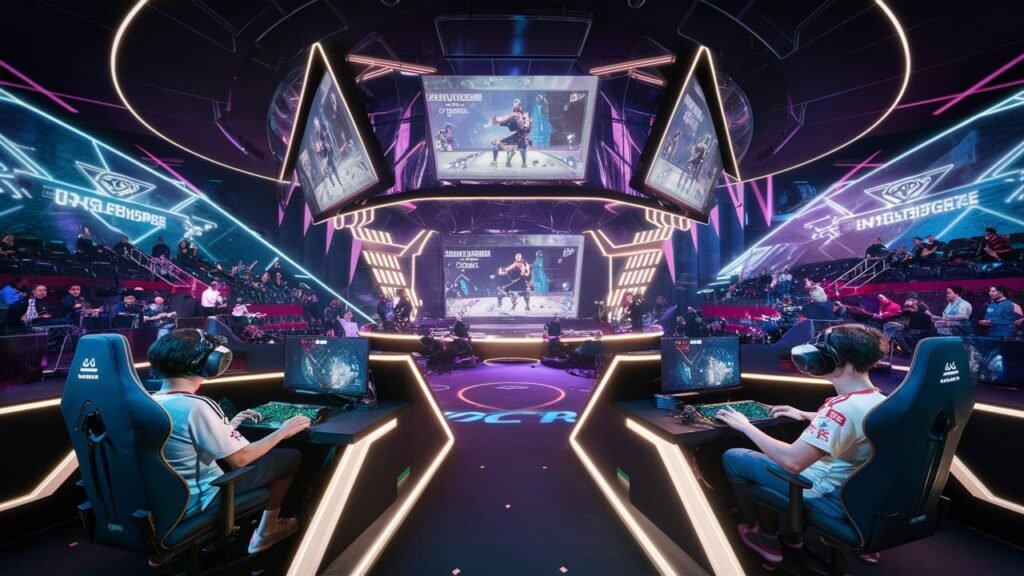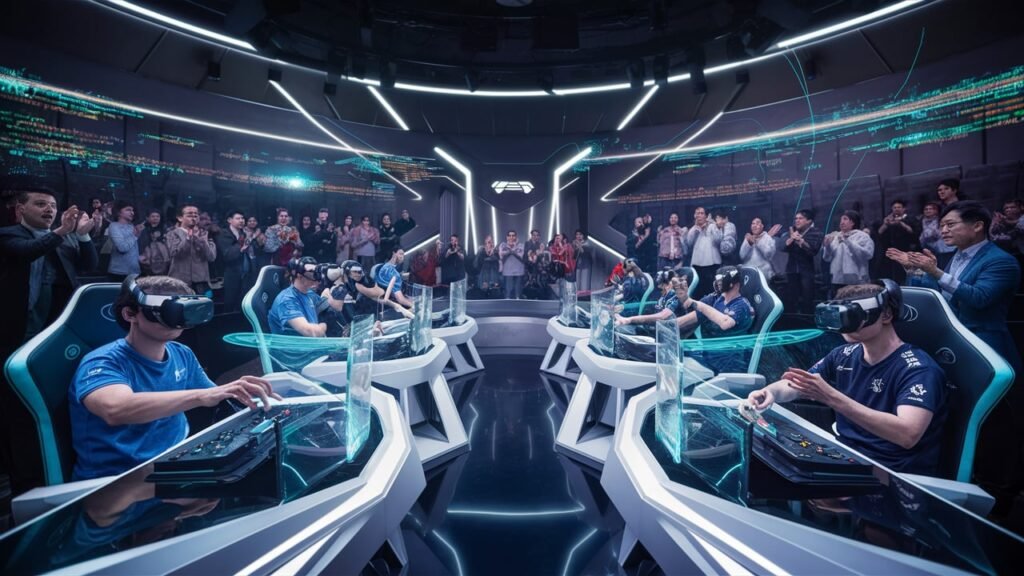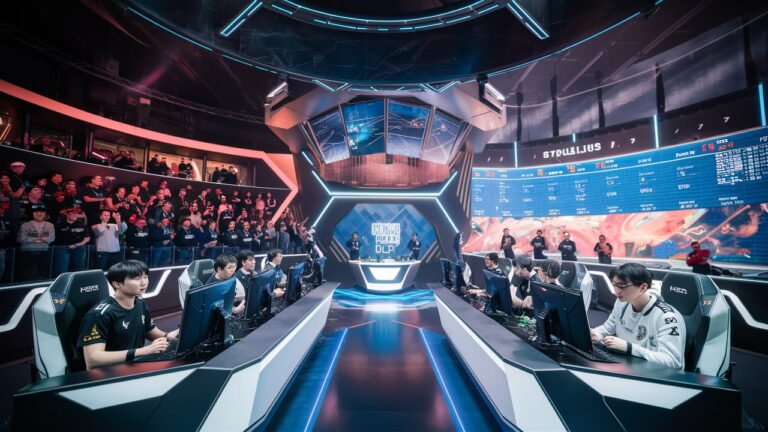The world of eSports has evolved rapidly over the last few years, transforming from a niche activity into a multi-billion-dollar global industry. Central to this growth is the role of technology. From advancements in gaming hardware to cutting-edge software and innovative streaming platforms, the tech industry has played a crucial role in shaping the world of eSports.
In this article, we will explore how tech and eSports intersect, the technological developments that are driving the industry forward, and the future trends that are likely to redefine competitive gaming.
What is eSports?
eSports, short for electronic sports, refers to organized, multiplayer video game competitions, particularly between professional players, individually or as teams. These competitions can take place both online and offline, with events streamed live to millions of viewers across the globe. The most popular eSports games include titles like League of Legends, Dota 2, Counter-Strike: Global Offensive, Fortnite, and Overwatch.
While eSports may have initially been seen as a hobby or informal competition, it has now become a professional industry with its own leagues, sponsorships, and global audiences. Competitive gaming events are hosted in large arenas and broadcast worldwide, attracting sponsorship deals from major brands and generating massive revenue through advertisements, ticket sales, merchandise, and digital streaming platforms.
How Technology Powers eSports
Technology is not only transforming how games are played but also how they are broadcast, monetized, and experienced by viewers. Here are some key areas where technology is influencing the eSports landscape:
1. Gaming Hardware: The Backbone of Competitive Gaming
At the heart of every eSports competition lies high-performance gaming hardware. The technology behind gaming consoles, PCs, and accessories is crucial to ensure that players can compete at the highest levels without performance issues. The following technologies play a central role in competitive gaming:
- High-End PCs: The most competitive eSports games require powerful gaming rigs to process complex graphics, high frame rates, and multi-player environments. PCs are equipped with top-of-the-line processors, graphics cards (GPUs), and fast storage devices to reduce lag and ensure smooth gameplay.
- Monitors with Low Latency: Fast refresh rates and low latency monitors are essential for eSports players who need to respond quickly to in-game events. Monitors with refresh rates of 144Hz or higher are commonly used by professional gamers.
- Gaming Peripherals: Professional gamers rely on specialized equipment like mechanical keyboards, ergonomic mice, gaming headsets, and controllers to gain an edge. These peripherals are optimized for performance, precision, and comfort during long hours of gaming.

The constant development of gaming hardware, with innovations such as graphics improvements and reduced latency, is crucial to maintaining the competitive integrity of eSports.
2. Software and Game Development: The Role of Tech in Creating Competitive Titles
The design and development of eSports games rely heavily on advanced technology. Game developers use state-of-the-art software tools to create immersive experiences that allow for smooth gameplay, balance, and competitive fairness. Key aspects include:
- Game Engines: Popular game engines like Unreal Engine and Unity are used by developers to create highly interactive and visually stunning environments that form the foundation of eSports titles. These engines help ensure that games run smoothly across different hardware and platforms.
- AI and Machine Learning: Game developers are increasingly using artificial intelligence (AI) to create dynamic in-game environments, develop intelligent NPCs (non-player characters), and provide adaptive difficulty levels for players. Machine learning techniques are also being used to analyze player behavior, improving matchmaking systems and ensuring fair and balanced competitions.
- Game Balancing: Maintaining a balanced and fair gaming experience is key to eSports. Developers continually monitor and tweak the game’s mechanics, characters, and overall gameplay to ensure that no player or team has an unfair advantage. This requires constant updates and patches based on player feedback and in-game data analysis.
3. Streaming Technology: The eSports Viewing Experience
One of the most significant advancements in eSports is the rise of live streaming. With millions of fans around the world tuning into their favorite games and players, streaming platforms like Twitch, YouTube Gaming, and Facebook Gaming have become the go-to destinations for watching eSports events. The technology behind these streaming platforms ensures high-quality broadcasts and interactive viewer experiences.
- Streaming Quality: Advances in internet speeds and video compression technologies have made it possible for streamers and viewers to enjoy high-definition streams with minimal buffering. Platforms support streams in 4K resolution, offering a more immersive viewing experience for fans.
- Interactive Features: Streaming platforms are incorporating interactive features like real-time chat, live polls, and fan donations, allowing viewers to engage with streamers and events. Features like these help create a community-driven experience that enhances fan loyalty and interaction.
- Virtual Reality (VR) and Augmented Reality (AR): New technologies, such as VR and AR, are beginning to transform how fans experience eSports events. VR allows fans to feel as though they are inside the game or the arena, offering an unparalleled immersive experience. AR can be used to enhance broadcasts with live stats and visual effects, providing a more interactive viewing experience.

4. Cloud Gaming and eSports
Cloud gaming, or gaming-as-a-service, is another technological advancement that could revolutionize the eSports scene. With cloud gaming, players can access and play games from remote servers without needing high-end hardware. This has several implications for eSports:
- Access to eSports for More Players: With cloud gaming, more individuals can participate in eSports competitions without the need for expensive gaming equipment. This opens up competitive gaming to a broader audience, increasing both the talent pool and the fanbase.
- Reduced Latency: With the development of 5G networks, cloud gaming can offer lower latency, allowing for smoother and more competitive gameplay. As cloud infrastructure improves, eSports events could be played remotely, with players participating from anywhere in the world while still maintaining a high level of performance.
5. Esports Analytics and Data-Driven Strategies
Data analytics has become a vital part of modern eSports. Teams, players, and coaches use data to refine their strategies, understand opponents, and improve individual performance. Technology plays a crucial role in collecting and analyzing gameplay data, such as:
- Match Analytics: Real-time data collection during eSports tournaments allows analysts to assess player behavior, strategy, and decision-making. This data can be used to identify weaknesses and optimize team tactics.
- Performance Metrics: Metrics such as reaction time, accuracy, and decision-making speed are tracked to assess player performance. By leveraging this data, teams can enhance their training and make informed decisions on player selection and strategies.
- AI-Driven Insights: AI and machine learning algorithms are used to analyze vast amounts of gameplay data to find patterns and predict outcomes, helping coaches and teams fine-tune their performance in upcoming matches.
6. eSports Platforms and Online Leagues
The rise of eSports leagues and online tournaments has been facilitated by advanced tech platforms that allow for seamless competition. These platforms provide tools for scheduling events, managing registrations, tracking player stats, and live streaming matches.
For example, platforms like Battlefy and Faceit enable gamers to sign up for tournaments, track match results, and compete in various eSports games. These platforms also allow for an integrated experience that supports player matchmaking, spectator engagement, and tournament broadcasting.

The Future of Tech in eSports
Looking to the future, tech is set to further transform the eSports industry. Here are some trends and technologies that could shape the next phase of eSports:
- 5G Connectivity: The widespread rollout of 5G networks promises to reduce latency significantly, making online competitions smoother and more responsive.
- Artificial Intelligence and Automation: AI-powered systems will continue to refine eSports games, improve matchmaking, and provide more personalized experiences for both players and viewers.
- Blockchain Technology: Blockchain could change how prizes and in-game items are managed, allowing for secure transactions, ownership of digital assets, and transparent tournament structures.
- Esports in VR/AR: As VR and AR technology matures, immersive eSports tournaments and fan experiences may become more common, allowing fans to feel as though they are physically at the event or inside the game world itself.
Conclusion
The world of eSports has grown into a highly sophisticated and technology-driven industry, with tech advancements continuously pushing the boundaries of what’s possible in gaming, streaming, and audience engagement. From high-performance gaming hardware to cloud gaming solutions and data-driven strategies, technology is integral to both the competitive side and the viewing experience of eSports.
As eSports continues to grow, the synergy between tech and competitive gaming will only strengthen, offering exciting possibilities for players, fans, and businesses alike. Whether through improved gaming experiences, innovative streaming platforms, or data-powered strategies, the future of eSports will undoubtedly be shaped by the ongoing evolution of technology.

